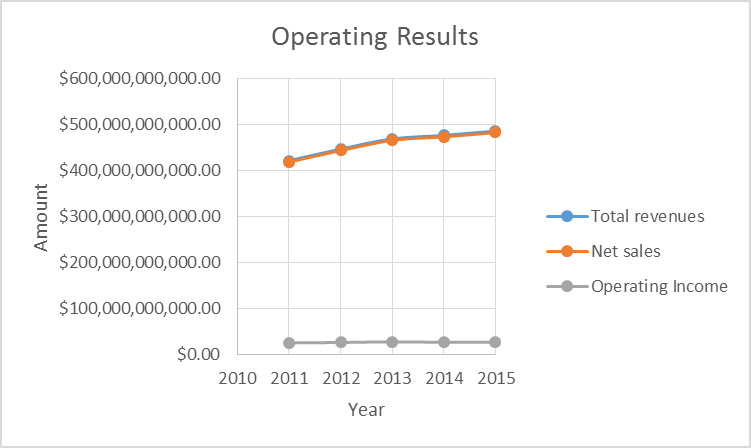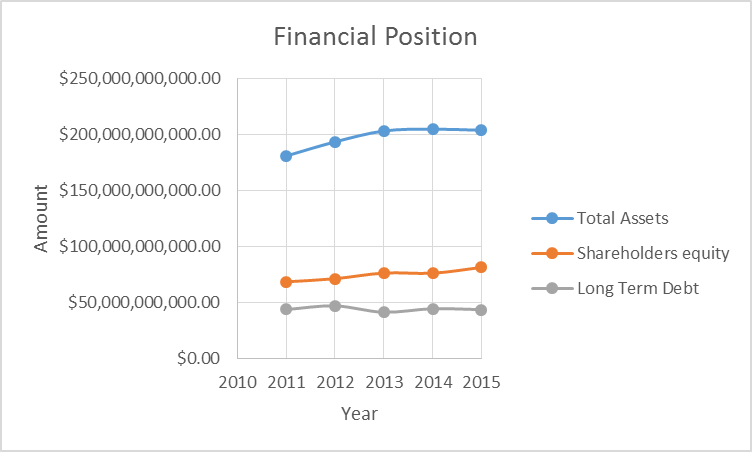Walmart Company Profile
Walmart is a large retail chain with well-arranged and strategically located stores in various continents. These stores apply the latest technology in the management of their activities. The company has had a substantial growth in its client base due to the development of mobile shopping technology. Using this technology, most customers can shop online and collect the goods bought from the nearest Walmart store (Corporate Reports 6).
The company’s unique features such as allowing customers to propose the prices of commodities, access, experience, and assortment have made it the preferred seller to many consumers. The chain has a wide range of commodities exceeding 10 million items as of 2015 (Corporate Reports 8).
The company operates in countries such as China, Canada, Mexico, United Kingdom, and Brazil (Corporate Reports 3). The ability of the company to stock fresh food and innovative e-commerce gives the establishment a competitive edge over other retail chains. The Walmart chain was among the best performers among large retail chains in the United States with high sales exceeding $141 billion in 2015 (Corporate Reports 4). The stores serve nearly 260 million customers in 27 countries with a large number of employees. The large number of employees (approximately 800,000) is an indication of the company’s commitment to offering quality services to its client base.
Financial Overview for Five Years
The financial stability of every firm is determined by the ability of the firm to manage its financial resources appropriately. The progress of a company is pegged on the soundness of its financial acquisition, utilization, and planning. The growth of Walmart’s financial base and profitability can be attributed to good financial management systems and tools. The company employs the latest technology that enables it to achieve exceptional results.


From the above graphs, net sales, operating income, and net revenue have had an upward trend since 2011. The finances indicate that the company has realized positive growth over the last five years as indicated by an increase in the total assets and shareholders’ equity (the financial position graph). In the year 2015, the net sales hit the highest mark.
Current Market Situation
The market is highly competitive with numerous stores that offer similar products and services. Therefore, the market poses opportunities as well as challenges to the retail chain (McCammon 35). The ability of the retail chain to diversify and stock millions of items keeps it ahead of market expectations. The market that is served by e-commerce in the major areas where the retail chain operates has grown rapidly. As a result, the retail chain has also invested in e-commerce to keep up with the market demands.
Market Description
The markets served by the company consist of informed consumers who are aware of the latest trends, bargains, after-sale services among many other customer services. Serving knowledgeable consumers is quite challenging because such clients have adequate facts regarding their rights as consumers including the prices of similar commodities from other sellers. The retail chain understands its market and offers a wide range of products at competitive prices to its customers. The market consists of other large and small retail outlets that pose competition to Walmart. However, Walmart manages to keep up with the competition due to its specialization in the retail market. The market also comprises consumers of various ages, gender, attitudes, and lifestyles. Additionally, the geographic location of the market varies since Walmart serves a global market.
Product Review
The retail market is unique with millions of products from all over the world. Therefore, consumers can make choices from a wide selection of commodities. The range of products available for a single line may be from different manufacturers, for instance, washing detergents that are sold by hundreds of manufacturers. Therefore, the retail chains have to stock a variety of these commodities to suit their customers’ needs and tastes. The Walmart market in the United States, for example, is not as competitive as that in Brazil and the United Kingdom. The differences in competitiveness indicate that product variability exists in different countries.
Competitive Review
Competition in the business arena is a constant phenomenon. Therefore, competitive companies have the advantage of remaining in profitable business. The ability of a firm to compete effectively is determined by the nature of the competition and the financial capability of the firm (Lynch 309). The application of technology also plays a vital role in giving a firm a competitive advantage over its business rivals. Walmart, for instance, uses e-commerce to target clients who live away from their retail stores. This move has enabled the company to increase its sales. Such clients can order goods from the firm’s online stores and collect the purchased items from retail stores in their vicinity. Bulky items can be delivered to the clients’ residential addresses using company trucks.
Logistics Review
The nature of the customers and their locality substantially influences the processes that goods undergo before being delivered to the customers. The channels that the store chooses are dependent on the number of clients to be served and their geographical concentration. As a result, it becomes challenging to provide home delivery services to widely dispersed customer populations because the per-unit costs of delivery increase significantly (Frazier 37).
The use of logistic companies to ferry goods also becomes uneconomical to the business. These complications have discouraged the company from venturing into such markets. The company, however, has used the e-commerce platform effectively. The company’s ability to purchase its commodities in large volumes directly from manufacturers has enabled its source and ship goods at fair prices. Consequently, the reduced logistic costs of the company have enabled customers to benefit in terms of buying goods at fair prices and better customer services.
The ability of the company to use trucks to deliver commodities has contributed to the increased sales volumes realized by the company. Most companies can meet their sales targets through intensive marketing without growing their distribution channels (Manna 78).
Walmart maintains short distribution channels for most of its products to lower handling costs and minimize the time taken to make deliveries. The management of short distribution channels is more rewarding than the management of longer channels, which make planning work tedious and time-consuming. Product factors that dictate the distribution and logistics of products include perishable goods, breakables, and luxury items. The handling of goods belonging to these categories is done at departmental levels to ensure that every category of goods receives specialized attention (Shang et al. 56).
Works Cited
Corporate Reports 2015. Walmart Annual Report 2015. Web.
Frazier, Gary L., Elliot Maltz, Kerry Antia, and Aric Rindfleisch. “Distributor Sharing of Strategic Information with Suppliers.” Journal of Marketing 73.2(2009): 31–43. Print.
Lynch, Richard. Corporate Strategy. 4th ed. 2006. Harlow, Essex: Prentice-Hall. Print.
Manna, Dean R. “Just-In-Time: Case Studies of Supplier Relationships Across Industries.” Journal of Applied Business Research 24.1(2008): 75–83. Print.
McCammon, B.C., Jr. “Perspective for Distribution Programming.” Marketing Channels. Eds. A. Coughlan, E. Anderson, L.W. Stern, and A.I. El-Ansary, London: Pearson International Edition, 2008. 30-55. Print.
Shang, Jennifer, Tuba Pinar Yildirim, Pandu Tadikamalla, Vikas Mittal, and Lawrence H. Brown. “Distribution Redesign for Marketing Competitiveness.” Journal of Marketing 73.2(2009): 146–163. Print.